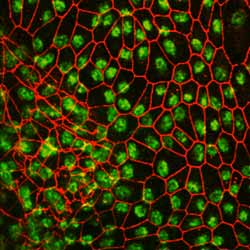IUPUI Stem Cell Research Could Expand Clinical Use of Regenerative Human Cells

Retinal Pigment Epithelial (RPE) cells derived from human induced pluripotent stem cells possess numerous characteristics of native RPE cells when examined by immunocytochemistry.<br>
The study of human induced pluripotent stem cells (hiPSCs) has been pursued vigorously since they were first discovered in 2007 due to their ability to be manipulated into specific cell types.
Scientists believe these cells hold considerable potential for cell replacement, disease modeling and pharmacological testing. However, clinical applications have been hindered by the fact that, to date, the cells have required animal products and proteins to grow and differentiate
A research team led by Jason S. Meyer, Ph.D., assistant professor of biology, successfully differentiated hiPSCs in a lab environment—completely through chemical methods—to form neural retinal cell types (including photoreceptors and retinal ganglion cells). Tests have shown the cells function and grow just as efficiently as those cells produced through traditional methods.
“Not only were we able to develop these (hiPSC) cells into retinal cells, but we were able to do so in a system devoid of any animal cells and proteins,” Meyer said. “Since these kinds of stem cells can be generated from a patient’s own cells, there will be nothing the body will recognize as foreign.”
In addition, this research should allow scientists to better reproduce these cells because they know exactly what components were included to spur growth and minimize or eliminate any variations, Meyer said. Furthermore, the cells function in a very similar fashion to human embryonic stem cells, but without controversial or immune rejection issues because they are derived from individual patients.
“This method could have a considerable impact on the treatment of retinal diseases such as age-related macular degeneration and forms of blindness with hereditary factors,” Meyer said. “We hope this will help us understand what goes wrong when diseases arise and that we can use this method as platform for the development of new treatments or drug therapies.”
“We’re talking about bringing stem cells a significant step closer to clinical use,” Meyer added.
Meyer, along with two graduate students, have worked for two years on this research with the help of an Indiana University Collaborative Research Grant and funding from the School of Science at IUPUI and the American Health Assistance Foundation.
The research will be published in the April edition of Stem Cells Translational Medicine. Co-authors include Akshayalakshmi Sridhar and Melissa M. Steward.
Meyer began researching hiPSCs while he was a post-doctoral research associate at the University of Wisconsin in Madison, where James Thomson, Ph.D., was one of two investigators to develop hiPSCs from adult cells in 2007. The other, Shinya Yamanaka, Ph.D, from Japan’s Kyoto University, was awarded the Nobel Prize for Physiology or Medicine in 2012 for discovering the ability of mature cells to be reprogrammed into stem cells.
Media Contact
All latest news from the category: Life Sciences and Chemistry
Articles and reports from the Life Sciences and chemistry area deal with applied and basic research into modern biology, chemistry and human medicine.
Valuable information can be found on a range of life sciences fields including bacteriology, biochemistry, bionics, bioinformatics, biophysics, biotechnology, genetics, geobotany, human biology, marine biology, microbiology, molecular biology, cellular biology, zoology, bioinorganic chemistry, microchemistry and environmental chemistry.
Newest articles

Properties of new materials for microchips
… can now be measured well. Reseachers of Delft University of Technology demonstrated measuring performance properties of ultrathin silicon membranes. Making ever smaller and more powerful chips requires new ultrathin…

Floating solar’s potential
… to support sustainable development by addressing climate, water, and energy goals holistically. A new study published this week in Nature Energy raises the potential for floating solar photovoltaics (FPV)…

Skyrmions move at record speeds
… a step towards the computing of the future. An international research team led by scientists from the CNRS1 has discovered that the magnetic nanobubbles2 known as skyrmions can be…





















